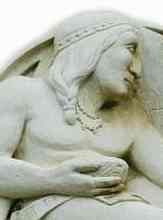


Relief, Sledd Hall |
Characteristics
of the Collegiate Gothic Style
The
term Collegiate Gothic derives from Gothic Revival, an architectural
style inspired by medieval Gothic architecture. Beginning in the
mid-18th century, Gothic Revival became a leading building style during
the 19th century and was often employed because of its moral overtones
for academic, political, and religious buildings.
|
| Arches. | Entrances
are often recessed and framed by arches. Arches are curved constructions
which span an opening.
Example |
| Balustrade. | A balustrade is a low railing made of stone, wood, metal, glass, or other materials and designed to prevent falls from roofs and other elevated architectural areas. |
| Buttress. | Buttresses
appear as decorative elements in some Collegiate Gothic buildings.
A buttress is an exterior support projecting from the face of a wall and
serving either to strengthen it or toresist the thrust created by the load
on an arch or a roof.
Example |
| Crenelation. | Name
given to a treatment of a railing or low wall in which an upright section
(called a merlon) alternates with a space (a crenelle) in a series.
Example |
| Dormer. | A
dormer is a window set upright on a sloping roof; sometimes this term refers
to the actual roof of such a projected window.
Example |
| Drainage spout. | Drainage
spouts are often elongated and decorated in Gothic Revival buildings.
A decorated water spout projecting from a building is one meaning of the
term 'gargoyle'.
Example |
| Fenestration. | Window
treatment. Gothic style buildings often have elaborate fenestration.
Example |
| Finial. | A
decoration on the point of a spire, pinnacle, or conical roof.
Example |
| Gargoyle. | Ornament,
usually a fantastic creature, projecting from a building; a decorated water
spount projecting from a building.
Example |
| Entrances. | Principle
entrances in buildings of this style are often recessed and arched.
Example |
| Parapet. | The wall above a roof line. See "balustrade". |
| Plaque. | A
tablet applied to or set within an exterior surface. Can have an inscription
or relief sculpture. See also 'medallion'.
Example |
| Quoin. | Hard
stone or brick used, usually decoratively, to reinforce an external corner.
Rustic quoins (see Rustication) are often used in this style.
Example |
| Relief Sculpture. | Figurines
atop arches or windows and reliefs on exterior walls are sculptural elements
that appear on some buildings.
Example: Mucozo relief, top left, this page |
| Roofing. | Orange slate tiles (or facsimiles) are often applied to the roof. |
| Rustication. | Rustication
is applied to the corners. Coming from the word 'rustic', rustication
implies a rough look. Rustication in building is stonework (often
limestone) whose blocks are separated by deep grooves called chamfers.
The stonework typically has a rough texture but can sometimes be smooth.
Example |
| Tracery. | Curvilinear
shapes creating a pattern in a window.
Example |
| Walls. | Brick is used for the exterior walls. The bricklaying style is often English bond. |
| Windows. | Bay
windows (windows that project outward) are characteristic of some buildings.
Example |
| - | |
| - | Source: Historic Architecture Sourcebook. Edited by Cyril M. Harris. (New York: McGraw-Hill: 1977). |
|
|
| Historic Sites | UF Builds | Introduction |
| Page Author: Edward H. Teague
Contact: Ann Lindell Page Created: 31 Augut 1999 Page Updated: 2 February 2000 |